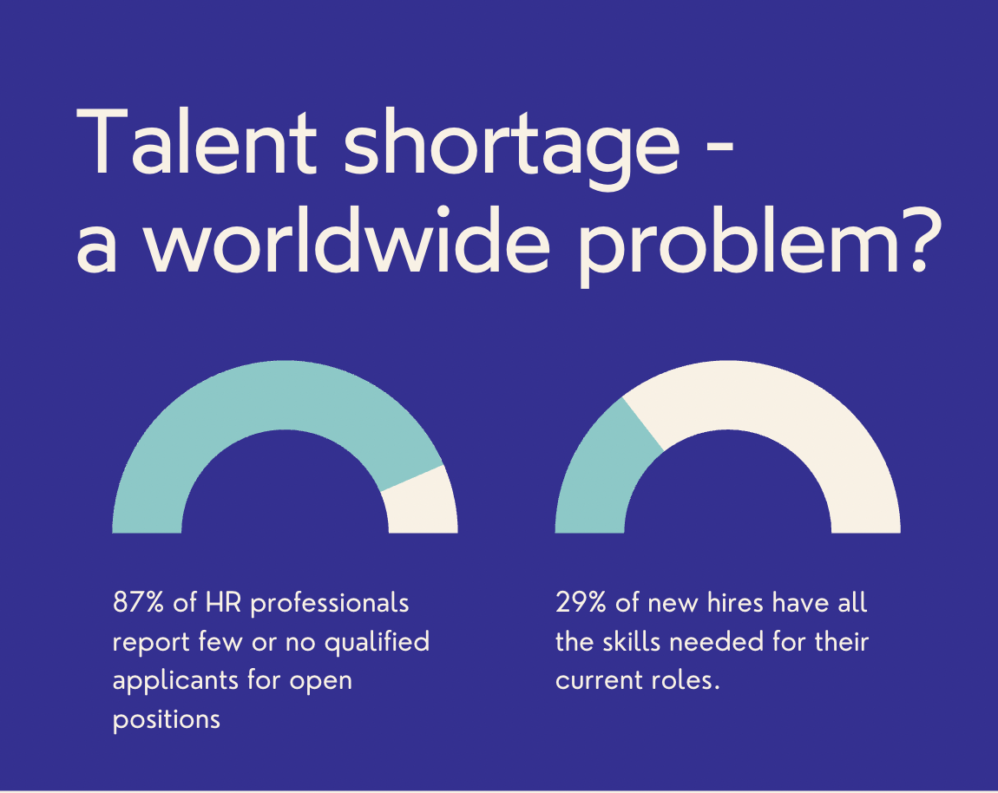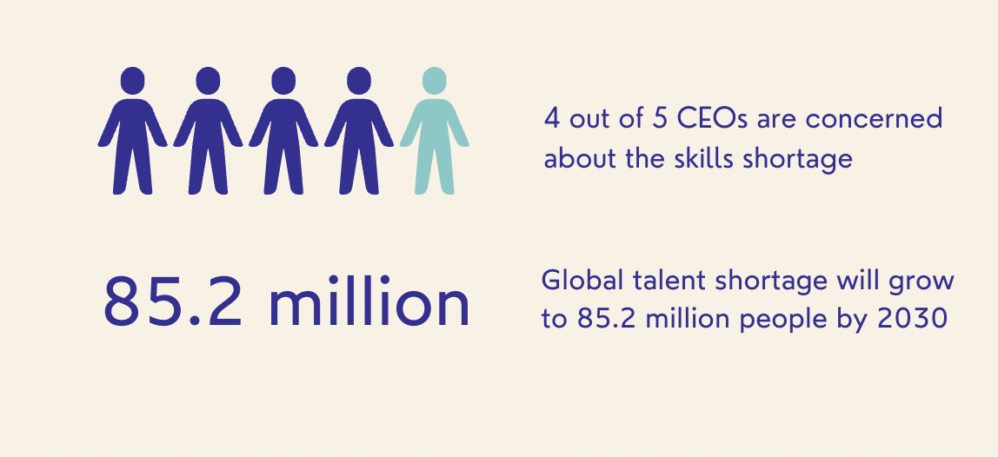A better way to find and retain top talent

We’re living through a revolution. The Covid 19 pandemic has changed businesses in unprecedented ways, forcing leaders to think outside the box. But as much as it’s a challenge, it’s also an opportunity to hire talented people. The only question is where to find them.
In the 1940s, Hewlett-Packard was an average company struggling to survive. But when World War II ended, legions of great engineers came out of U.S. military labs looking for new jobs. That was an opportunity Bill Hewlett and Dave Packard couldn’t pass up. When asked how they could afford to keep hiring during those difficult years, the answer was simple: “How could we afford not to!”
Let’s face it; recruitment is costly and time-consuming. As an HR manager, you’ve probably experienced the pressure to optimize costs while maintaining the high quality of new hires. And the question of where to source top talent remains one of the biggest challenges of modern HR.
Executives admit talent shortage worldwide
With global competition, every time you find a suitable candidate, others will likely be looking for that person as well. Moreover, candidates have become very picky about who they work for. Skilled professionals expect not only a high salary and tailored benefits but some “employment value proposition.”
On the other hand, executives admit they have an immense problem with talent shortage. A study by the National Federation of Independent Business (1) found that 87% of HR professionals in the US report “few or no qualified applicants” for open positions. Another study states that the global talent shortage will grow to 85.2 million people by 2030 (2). According to The Economist, four out of five CEOs are concerned about the skills shortage, and only 29% of new hires have all the skills needed for their current roles. (3)

If sourcing talent is so problematic, how can you ensure your recruitment pipeline brings the best candidates on board? Before you assess where to look for them, ask yourself three basic questions:what skills you are looking for, who the top performers in your organization are, and where these A-players are coming from. Answering these questions, along with some data-driven insights, will help you reshape your recruiting pipeline and manage talent better.
If you lack data, you might think of implementing people analytics solution, such as the one offered by Human Panel. With our platform, you can organize all your workforce data in one place. Simple graphs and visualized statistics replace obscure spreadsheets and help you make informed HR decisions. To see how it works, sign up for a free demo – just fill in the short form below.
Ready to start people analytics with Human Panel?
What skills are you looking for?
The first point you should define is the set of desired skills you are looking for. According to LinkedIn data, the most searched skills in the market include cloud computing, artificial intelligence, human resource management, UX design, mobile app development, video production, sales leadership, blockchain, translation, audio production, and project management.
But today, soft skills can weigh more than technical ones. Creativity, persuasion, collaboration, time management, adaptability, and a coaching mindset are equally important. Even IT development teams need them, as IT is now much about identifying problems and creating solutions.
For a successful hire, you need to assess the candidate’s soft skills. This is critical because soft skills tell you how hard it will be to keep that talent in your company.
Daniel Aduszkiewicz, CEO & Co-Founder of Human Panel.
Crucially, as an HR manager, you should look beyond the immediate need and consider what skills your business needs to acquire to succeed in the future.
“Hiring people solely for their hard skills can also mean you’re not hiring good employees. You want people on your team who are good at communication, collaboration, taking ownership, and personal development. These are the skills you want to have in the long run. Because if you only have average talent in your company, you will never attract the best from the market,” adds Daniel Aduszkiewicz.
Create your source of talent
So how can you test people for soft skills such as ambition, curiosity, or the ability to learn? One approach can be based on the good old guidelines for excellent recruitment: create a profile of the candidate you want to hire before you even post a job ad. Outline the qualities and competencies of your ideal candidate. During the interview, ask behavior-based questions and check references. A long history of research shows that third-party opinions are often much more accurate than self-assessment.

If you place less emphasis on formal experience, you will inevitably come to the second technique of skills sourcing: looking beyond traditional talent pools, e.g. at universities and colleges. It can help you cut costs significantly and save on job ads.
“If you’re part of a global organization, you probably have a university or college program that can help you attract talent. Measure what talent that source brings and if they are one of your top performers, strike while the iron is hot. Instead of spending money on headhunters, you can target the exact people you need early in their careers. Why not invite students in for a summer internship and try to retain them?” asks Daniel Aduszkiewicz.
Know your top performers
But to know where to look for candidates, you first need to understand who your A player is. What is their background? Where did they graduate from? Has this person been promoted within your structures or perhaps from an internship program?

The good news is that you probably already have this data. The key is to go through it and determine what kind of people you want to hire for specific positions. A well-designed analysis will arm you with answers, and the results can be astonishing. For example, some companies’ star performers come from vocational schools or have military service experience. And why? Because someone who worked as a teenager or joined the military to pay for college may be more motivated than someone with a privileged background.
“If you don’t know what the most useful sources are in your organization, you’re looking all over the place for candidates, which increases costs. Recruitment processes are ridiculously costly and time-consuming, so you’d better know where you have a higher chance of success. It would be best if you didn’t base your candidate assessment on popular opinions like ‘we only hire graduates from X.’ In such a case, you need to back up your decision with data,” says Daniel Aduszkiewicz.
Act now – support your decisions with data. Try our people analytics platform that will help you organize all your workforce data and structure all your processes. Sign up for a free demo and see what we can do to improve your HR management.
Ready to start people analytics with Human Panel?
Recognize internal talent
Data is critical for recruiting because it allows you to build an efficient talent pipeline and measure employees’ performance. As you scan your champions, you may find that the source is not the key to their success. It may turn out that top performance lies in who they work with or what task they’ve been assigned. And perhaps instead of always looking outside for new employees, you should sometimes look inside your organization.
Data shows that internally hired employees have a shorter onboarding period and are generally paid less than external candidates. Ask the right questions and see if posting on an internal job board could be an effective source of talent acquisition.
There are no golden rules that work for everyone. Don’t rely solely on your observations and beliefs that a particular source is the source of your top players. Seek validation for your opinion and don’t follow the steps of others. A strategy that worked for your competitor doesn’t have to work for you.
Daniel Aduszkiewicz
Aduszkiewicz emphasizes that the work environment is changing so fast that the agile approach is necessary. Researchers note that most jobs will require up to 10 new skills within 18 months (4), while the World Economic Forum predicts that 65% of today’s jobs will no longer exist in 15 years (5). That means understanding what works for your business and what doesn’t. “Using the same tactics for all businesses is nothing more than a waste of money. What worked ten years ago is outdated today. That’s why, as a leader, you should understand what is effective for your business, and that’s what data will show you. Analytical tools will give you hard evidence of which solutions are the most powerful. And which ones are the most cost-effective.”
How to retain talents?
Once you’ve identified your top performers, work to keep them onboard, because the numbers are merciless. The cost of voluntary turnover was over $630 billion in 2020 in the United States alone. More than one-third of those who leave do it within the first 365 days. Over 30% cite lack of support and development opportunities as the reason for their decision.(6)

To retain your top talent, you need to offer more than just regular raises. Ask your employees what skills they consider their best and which ones they’d like to develop. Which parts of the job are most rewarding for them? What is the biggest challenge? What are the employee’s goals? Is there anything they would still like to learn?
Once you’ve identified the needs and wants, look for ways to develop and train them. Try to maintain an employee-centric approach when doing this. Many companies have their training and development programs, but they are often not designed with the “employee experience” in mind. Keeping this in mind will help you better address employees’ personal needs.
Wrap-up
Talent acquisition seems like a complicated task, and most HR leaders admit they struggle with a shortage of highly skilled professionals. However, it could also be due to inadequate hiring practices. The pandemic crisis has accelerated changes in the talent landscape, and those who fall short will pay. The number of job openings has increased in recent months, and the competition will be fierce.
To manage talent acquisition and retention better, profile your ideal candidate and determine what hard and soft skills that person should have. Look at who your top performers are and where your best employees come from. Assess what’s best for you: angling students through university programs or accelerating internal promotions? Back up your decisions with data, and don’t just rely on opinions. Take a people-oriented approach and remember that the pandemic crisis will pass, and your company can come out a winner afterward. If you want to hire people for lasting greatness, now is the time.
Sources:
(1) https://www.nfib.com/surveys/small-business-economic-trends/
(2) https://www.kornferry.com/about-us/press/korn-ferry-study-reveals-global-talent-shortage-could-threaten-business-growth-around-the-world
(3) https://media.economist.com/sites/default/files/pdfs/Managing_Talent.pdf
(4) https://hbr.org/2021/03/reengineering-the-recruitment-process
(5) https://reports.weforum.org/future-of-jobs-2016/chapter-1-the-future-of-jobs-and-skills/
(6)https://info.workinstitute.com/hubfs/2020%20Retention%20Report/Work%20Institutes%202020%20Retention%20Report.pdf




